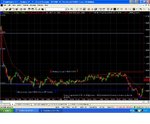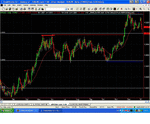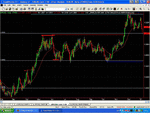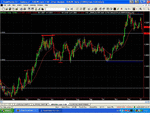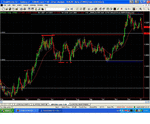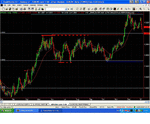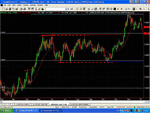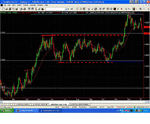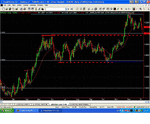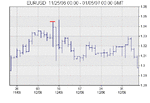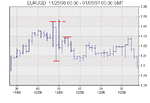JTrader
Guest
- Messages
- 5,741
- Likes
- 507
long @ support (S), short @ resistance (R), short @ minor R , long @ minor S
Hi
I'm putting this thread in forex, as i trade spot EURUSD, and so thought i may get a better/more relevant response than in the technical analysis forum.
It seems to me that there are a few ways that you can trade when support and resistance levels are hit by price.
You can look to trade a reversal, by buying @ support (S) and selling @ resistance (R).
You can also look to trade a breakout/momentum price continuation above or below S or R by selling @ minor R (once the nearby support level has been broken), or buying @ minor S (once the nearby R level has been broken).
Buying @ S or selling @ R.
1. You can either buy or sell when price hits that S or R level, hoping that a reversal will occur.
2. You can also wait for price to hit the S or R level, stall or bounce off that level showing signs of an imminent reversal, before buying or selling if the S or R level is hit again by price, hoping that a reversal will occur.
Buying @ resistance/minor support, selling @ support/minor resistance.
1. Particularly if momentum is strong/picking up speed, you can buy (go long) when price breaches the R level, and that former R level may then become minor S, hoping that a breakout/continuation up will occur.
Likewise, you can sell (go short) when price crosses/breaches the S level, and that former S level may than act as minor R, hoping that a breakout/continuation down will occur.
2. you can also look to buy (go long) when price breaches the R level, and that former R level may then become minor S, but wait for the price to retest that former R/potentially new minor S level before entering the trade, hoping that a breakout/continuation up will occur.
Likewise, you can sell (go short) when price crosses/breaches the S level, and that former S level may than act as minor R, but wait for the price to retest that former S/potentially new minor R level before entering the trade, hoping that a breakout/continuation down will occur.
Whether or not you are planning to make a reversal trade @ S/R, or make a breakout/momentum continuation trade, if S/R is broken, the following can apply -
1. If you enter the reversal trade when S or R is initially hit by price for the first time, sometimes that S or R level will fail and your SL will be hit.
2. If you enter the reversal trade after support has been hit, waiting for the price to stall/bounce off and then back to S/R before entering the trade, sometimes you will have missed the boat and not get this second opportunity to enter the trade, as the first bounce off S/R was successful. Or, you enter on the second bounce off S/R, and a win loss or draw is the trade outcome
3. If you enter a momentum continuation/breakout trade when S/R has initially just been breached for the first time, sometimes price will continue in your favour immediately, or retrace to within the old S/R level and hit your SL.
4. If you only enter a momentum continuation/breakout trade when S/R has been breached, and then you wait for a retest of/retracement to the former S/R = potentially new minor R/ minor S level to occur before entering the trade, you will either have missed the boat, as the first breach of S/R led to the momentum continuation, or you will get that 2nd opportunity to enter the trade, and a win loss or draw will be the trade outcome.
When you miss the boat on a trade, you can accept that you've missed the boat, and wait for the next trade entry opportunity. The some tempting opportunity is to enter late, once some of the profit has been missed, hoping that the reversal turns into a significant swing, or the momentum breakout turns into a trend, enabling you to still bag a healthy profit.
However, by entering trades connected to S/R late and at a less favourable entry price, you may often find that just as you enter the price stops moving in your chosen direction, reverses, you have already missed the available profit, and you end up getting stopped out.
Whatsmore, because you entered the trade late, your SL is not protected behind S/R or minor R/S and you get stopped out. The price may then retace back to the S/R level or minor R/S level, and then reverse back in your favour/chosen trade direction. If you had entered on time initially, closer to the S/R level in question, your SL wouldn't have been hit because it was protected behind S/R or minor R/S, and you remain in the trade.
Further issues
I'm really trying to find the best way to handle these situations.
There are advantages to entering on the first bounce, or waiting for the second bounce.
There are also advantages in entering a trade late/being hesitant in that because you were uncertain of what to do, you were waiting for "just that those few extra bits of info" that'd enable you to make an informed and successful decision 😉 .
While the negative aspect of being hesitant is that if you enter the trade, you enter the trade late and at a less favourable price.
The positive aspect of being hesitant is that your hesitancy keeps you out of some trades that then start to fail, and if you had been decisive and entered the trade, you would have taken a loss...........
To be continued.........
Hi
I'm putting this thread in forex, as i trade spot EURUSD, and so thought i may get a better/more relevant response than in the technical analysis forum.
It seems to me that there are a few ways that you can trade when support and resistance levels are hit by price.
You can look to trade a reversal, by buying @ support (S) and selling @ resistance (R).
You can also look to trade a breakout/momentum price continuation above or below S or R by selling @ minor R (once the nearby support level has been broken), or buying @ minor S (once the nearby R level has been broken).
Buying @ S or selling @ R.
1. You can either buy or sell when price hits that S or R level, hoping that a reversal will occur.
2. You can also wait for price to hit the S or R level, stall or bounce off that level showing signs of an imminent reversal, before buying or selling if the S or R level is hit again by price, hoping that a reversal will occur.
Buying @ resistance/minor support, selling @ support/minor resistance.
1. Particularly if momentum is strong/picking up speed, you can buy (go long) when price breaches the R level, and that former R level may then become minor S, hoping that a breakout/continuation up will occur.
Likewise, you can sell (go short) when price crosses/breaches the S level, and that former S level may than act as minor R, hoping that a breakout/continuation down will occur.
2. you can also look to buy (go long) when price breaches the R level, and that former R level may then become minor S, but wait for the price to retest that former R/potentially new minor S level before entering the trade, hoping that a breakout/continuation up will occur.
Likewise, you can sell (go short) when price crosses/breaches the S level, and that former S level may than act as minor R, but wait for the price to retest that former S/potentially new minor R level before entering the trade, hoping that a breakout/continuation down will occur.
Whether or not you are planning to make a reversal trade @ S/R, or make a breakout/momentum continuation trade, if S/R is broken, the following can apply -
1. If you enter the reversal trade when S or R is initially hit by price for the first time, sometimes that S or R level will fail and your SL will be hit.
2. If you enter the reversal trade after support has been hit, waiting for the price to stall/bounce off and then back to S/R before entering the trade, sometimes you will have missed the boat and not get this second opportunity to enter the trade, as the first bounce off S/R was successful. Or, you enter on the second bounce off S/R, and a win loss or draw is the trade outcome
3. If you enter a momentum continuation/breakout trade when S/R has initially just been breached for the first time, sometimes price will continue in your favour immediately, or retrace to within the old S/R level and hit your SL.
4. If you only enter a momentum continuation/breakout trade when S/R has been breached, and then you wait for a retest of/retracement to the former S/R = potentially new minor R/ minor S level to occur before entering the trade, you will either have missed the boat, as the first breach of S/R led to the momentum continuation, or you will get that 2nd opportunity to enter the trade, and a win loss or draw will be the trade outcome.
When you miss the boat on a trade, you can accept that you've missed the boat, and wait for the next trade entry opportunity. The some tempting opportunity is to enter late, once some of the profit has been missed, hoping that the reversal turns into a significant swing, or the momentum breakout turns into a trend, enabling you to still bag a healthy profit.
However, by entering trades connected to S/R late and at a less favourable entry price, you may often find that just as you enter the price stops moving in your chosen direction, reverses, you have already missed the available profit, and you end up getting stopped out.
Whatsmore, because you entered the trade late, your SL is not protected behind S/R or minor R/S and you get stopped out. The price may then retace back to the S/R level or minor R/S level, and then reverse back in your favour/chosen trade direction. If you had entered on time initially, closer to the S/R level in question, your SL wouldn't have been hit because it was protected behind S/R or minor R/S, and you remain in the trade.
Further issues
I'm really trying to find the best way to handle these situations.
There are advantages to entering on the first bounce, or waiting for the second bounce.
There are also advantages in entering a trade late/being hesitant in that because you were uncertain of what to do, you were waiting for "just that those few extra bits of info" that'd enable you to make an informed and successful decision 😉 .
While the negative aspect of being hesitant is that if you enter the trade, you enter the trade late and at a less favourable price.
The positive aspect of being hesitant is that your hesitancy keeps you out of some trades that then start to fail, and if you had been decisive and entered the trade, you would have taken a loss...........
To be continued.........
Last edited:

